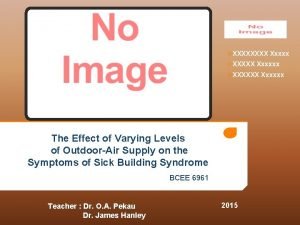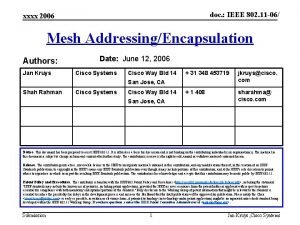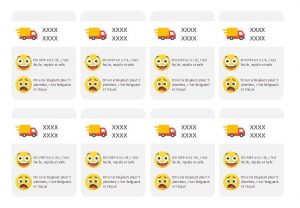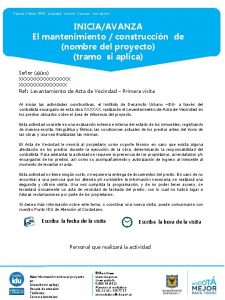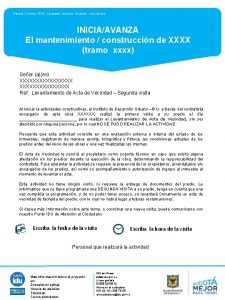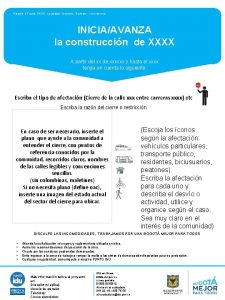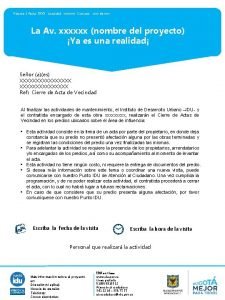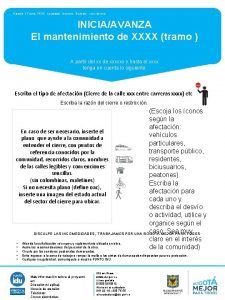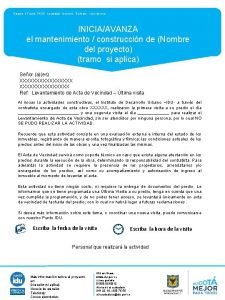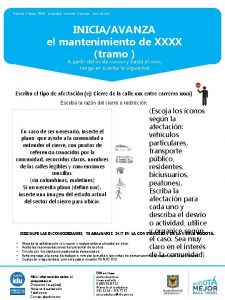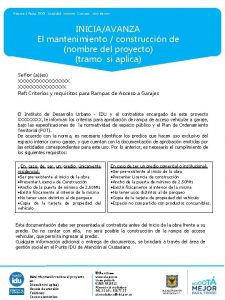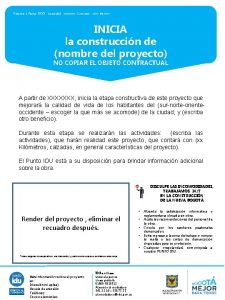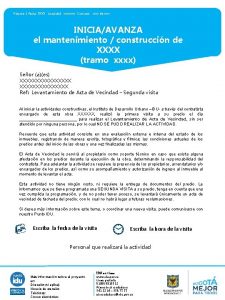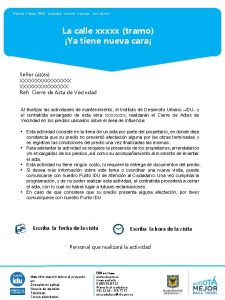doc IEEE 802 11 06 xxxx 2006 L













- Slides: 13

doc. : IEEE 802. 11 -06/ xxxx 2006 L 2 Mesh Services Description Authors: Date: June 1, 2006 Jan Kruys Cisco Systems Cisco Way Bld 14 San Jose, CA + 31 348 453719 jkruys@cisco. com Shah Rahman Cisco Systems Cisco Way Bld 14 San Jose, CA + 1 408 sharahma@ cisco. com Notice: This document has been prepared to assist IEEE 802. 11. It is offered as a basis for discussion and is not binding on the contributing individual(s) or organization(s). The material in this document is subject to change in form and content after further study. The contributor(s) reserve(s) the right to add, amend or withdraw material contained herein. Release: The contributor grants a free, irrevocable license to the IEEE to incorporate material contained in this contribution, and any modifications thereof, in the creation of an IEEE Standards publication; to copyright in the IEEE’s name any IEEE Standards publication even though it may include portions of this contribution; and at the IEEE’s sole discretion to permit others to reproduce in whole or in part the resulting IEEE Standards publication. The contributor also acknowledges and accepts that this contribution may be made public by IEEE 802. 11. Patent Policy and Procedures: The contributor is familiar with the IEEE 802 Patent Policy and Procedures <http: // ieee 802. org/guides/bylaws/sb-bylaws. pdf>, including the statement "IEEE standards may include the known use of patent(s), including patent applications, provided the IEEE receives assurance from the patent holder or applicant with respect to patents essential for compliance with both mandatory and optional portions of the standard. " Early disclosure to the Working Group of patent information that might be relevant to the standard is essential to reduce the possibility for delays in the development process and increase the likelihood that the draft publication will be approved for publication. Please notify the Chair <stuart. kerry@philips. com> as early as possible, in written or electronic form, if patented technology (or technology under patent application) might be incorporated into a draft standard being developed within the IEEE 802. 11 Working Group. If you have questions, contact the IEEE Patent Committee Administrator at <patcom@ieee. org>. Submission 1 Jan Kruys , Cisco Syatems

doc. : IEEE 802. 11 -06/ xxxx 2006 Intro • This slide set expands on our comments on the structure of the mesh functional/protocol specification – Notably wrt to the “Clause 9. x” Table of Contents Submission 2 Jan Kruys , Cisco Syatems

doc. : IEEE 802. 11 -06/ xxxx 2006 Objectives • Provide a simple view of what is really fairly complex behaviour – Breakdown complex functions into more easily comprehended subsets • Facilitate integration of security features – While retaining the possibility of adding security features without having to rewrite the whole standard • Facilitate combining functional description, protocol specification and frame formats for each part of the whole rather than for the whole – Improves validation and consistency checking – Improves review and commenting/updating Submission 3 Jan Kruys , Cisco Syatems

doc. : IEEE 802. 11 -06/ xxxx 2006 Basics • A model based on abstract services allows separation of functions such that each can be described in simple terms – The complete L 2 Mesh functionality comprises discovery, association between nodes, transporting data between nodes and across the mesh and setting up routes. • Each service has one or more invocations and each invocation has a result – Results may be conditions or data that are required for other services to function • Each service has its own protocol exchanges (frames or IEs) – If there is no protocol to be described, there is no need for a service description • Each service has its own security concerns and solutions Submission 4 Jan Kruys , Cisco Syatems

doc. : IEEE 802. 11 -06/ xxxx 2006 Services • Discovery – Allows MPs to find others MPs and their roles • Formation – Uses information provided by the Discovery Service – Allows MPs to set up links by setting up secure links between MPs that are considered neighbours according to some criteria • Transport – Gets the bits across a link between two neighbour MPs that have joined the mesh (using the Formation Service) • Routing – Creates routes to destinations inside or outside the mesh – uses the Transport Service • Forwarding – Delivers bits across the mesh using the Transport Service Submission 5 Jan Kruys , Cisco Syatems

doc. : IEEE 802. 11 -06/ xxxx 2006 Relationships of Services 802. 11 MAC User (LLC) Forwarding Service Routing Service Transport Service Other 802. 11 Functions Formation Service Discovery Service Basic 802. 11 MAC Services Submission 6 Jan Kruys , Cisco Syatems

doc. : IEEE 802. 11 -06/ xxxx 2006 Discovery Service • Invocation – Continuous but intermittent so as to conserve spectrum resources • Results – Alerts / Information about neighbouring MPs • E. g. (Mesh ID, MP Address, MP role (MP, MAP, MPP, Root. MPP), link quality/load, etc) • Protocol – Mesh beacons, Mesh Announcements, Mesh Probe/Response • E. g. Portal/Root announcements • Parameters – Rate of Beacons and Announcements • Rules – Forwarding of Beacons and Announcements • Security – None because there are no secure associations in place yet • Status – Lot of material in current draft but in different places Submission 7 Jan Kruys , Cisco Syatems

doc. : IEEE 802. 11 -06/ xxxx 2006 Formation Service -1 • Invocation – Alerts from Discovery Service – Internal Alerts resulting from solicited and unsolicited protocol exchanges • Results – Stable, secure links between neighbour MPs that are members of the same mesh – Up to date knowledge of available Mesh member MPs (MAP, MP) – Alerts to Routing service in case of loss of connections • Protocol – Mesh-Association • Sets up a secure association between MPs subject to successful mutual authentication – Mesh-Neighbour Query/Response • Is equivalent to 1 hop RREQ/RREP • Is used to get secure data on neighbour MPs – Portal/Root Arbitration and (Mesh Member) Registration • Makes sure that only one Root is active in a given mesh • Allows MAPs and MP to register their (client) addresses with a Portal or Root • May be used to control the number of active portals in a mesh Submission 8 Jan Kruys , Cisco Syatems

doc. : IEEE 802. 11 -06/ xxxx 2006 Formation Service-2 • Parameters – Mesh-ID, MP-ID, Mesh-AS-ID, MP-Role, Authentication Key ID, etc • Rules – Alerts (may) cause (new) Associations and or Query/Response exchanges with neighbours to update link conditions and statistics – Alerts due to Portal/Root Announcements (may) cause Mesh Registration updates • Security – Uses 11 i/r derived mutual authentication protocol to establish a security context between any pair of mesh nodes • Current status – Lot of material in the current draft but in different places. May need some reorg/updating Submission 9 Jan Kruys , Cisco Syatems

doc. : IEEE 802. 11 -06/ xxxx 2006 Transport Service • Invocation – Every transmission of data or management frame to any neighbour MP • Results – Secure delivery of the frame to the destination • Protocol – Basic 802. 11 transmission protocol (unicast/multicast) using EDCA for medium access • Parameters – Single frame for delivery to the same neighbour MP or group of MPs – Frame priority (relevant w. r. t. frame payload) – Appropriate encryption and message integrity keys • Rules – Basic 802. 11 transmission rules • Security – Payload Encryption and MIC Submission 10 Jan Kruys , Cisco Syatems

doc. : IEEE 802. 11 -06/ xxxx 2006 Routing Service • Invocation – Whenever a route to another MP (portal or other) is needed • Results – Best route to a given destination within the mesh • Protocol – Derived from AODV - as described in the current draft • Parameters – See draft • Rules – See draft • Security – Relies on Transport Service for secure delivery of routing frames Submission 11 Jan Kruys , Cisco Syatems

doc. : IEEE 802. 11 -06/ xxxx 2006 Forwarding Service • Invocation – Every transmission of a “user” data frame or set of “user” frames • “user” refers to an entity outside the mesh. – Under this definition transmitting a data packet to a neighbour node is a forwarding operation rather than a transport operation • user data frames may be received from neighbour MPs • Excludes management frames (of Formation and Routing Services) • Results – Secure delivery of user data frames to their intra-mesh destination • Protocol – Simple datagram unicast of encapsulated user data frame(s) using mesh forwarding header – Simple datagram broadcast of encapsulated user data frame(s) using mesh forwarding header • Parameters – Qo. S parameters of received and to-be-transmitted frames • Rules – Are there any that are visible from an operability point of view? • Security – Relies on the Transport Service for secure delivery of data (unless we decide in favour of e 2 e security across the mesh) Submission 12 Jan Kruys , Cisco Syatems

doc. : IEEE 802. 11 -06/ xxxx 2006 Summary • This document proposes a significant re-structuring of the TGs “mesh standard” – Notably in the area of the functional/protocol description • The main benefits are reduction of complexity in the description and facilitating maintenance of the draft/final text – Through the use of 5 abstract services that together model the full “mesh behaviour”. • The structure of the baseline standard has its problems – Mostly in multiple references to the same functionality – Combining all material related to a given function (e. g. Transport) under one heading breaks avoids those problems Submission 13 Jan Kruys , Cisco Syatems
